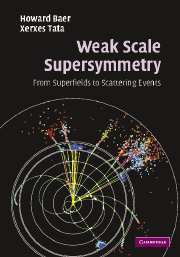Book contents
- Frontmatter
- Contents
- Preface
- 1 The Standard Model
- 2 What lies beyond the Standard Model?
- 3 The Wess–Zumino model
- 4 The supersymmetry algebra
- 5 Superfield formalism
- 6 Supersymmetric gauge theories
- 7 Supersymmetry breaking
- 8 The Minimal Supersymmetric Standard Model
- 9 Implications of the MSSM
- 10 Local supersymmetry
- 11 Realistic supersymmetric models
- 12 Sparticle production at colliders
- 13 Sparticle decays
- 14 Supersymmetric event generation
- 15 The search for supersymmetry at colliders
- 16 R-parity violation
- 17 Epilogue
- Appendix A Sparticle production cross sections
- Appendix B Sparticle decay widths
- Appendix C Higgs boson decay widths
- Bibliography
- Index
13 - Sparticle decays
- Frontmatter
- Contents
- Preface
- 1 The Standard Model
- 2 What lies beyond the Standard Model?
- 3 The Wess–Zumino model
- 4 The supersymmetry algebra
- 5 Superfield formalism
- 6 Supersymmetric gauge theories
- 7 Supersymmetry breaking
- 8 The Minimal Supersymmetric Standard Model
- 9 Implications of the MSSM
- 10 Local supersymmetry
- 11 Realistic supersymmetric models
- 12 Sparticle production at colliders
- 13 Sparticle decays
- 14 Supersymmetric event generation
- 15 The search for supersymmetry at colliders
- 16 R-parity violation
- 17 Epilogue
- Appendix A Sparticle production cross sections
- Appendix B Sparticle decay widths
- Appendix C Higgs boson decay widths
- Bibliography
- Index
Summary
Once sparticles are produced, they will typically decay into another sparticle together with SM particles via many different channels. The daughter sparticles subsequently decay to yet lighter sparticles until the decay cascade terminates in the stable LSP. In this discussion we have implicitly assumed that R-parity is conserved: otherwise, sparticles may also decay into just SM particles, and the final state would be comprised of only SM particles. However, whether or not R-parity is conserved, sparticle production at colliders typically leads to a variety of final state topologies via which to search for SUSY. Signal rates into any particular topology are determined by sparticle production cross sections studied in the last chapter, and by the branching fractions for various decays of sparticles.
In this chapter, we examine sparticle decays in the context of the R-parity conserving MSSM. As just mentioned, R-parity conservation implies that any sparticle decay chain will end in a stable LSP which may be a neutralino, a sneutrino, or, in models with local supersymmetry, also a gravitino. We have already seen in Chapter 9 that a sneutrino LSP is disfavored. A weak scale gravitino is essentially decoupled as far as collider physics considerations go. Hence, for most of this chapter, we will assume the gravitino is unimportant for sparticle decay calculations. However, as we saw in Section 11.3.1, an important exception to this occurs if the scale of SUSY breaking is low so that gravitinos are very light. To cover this possibility, we address sparticle decays to gravitinos in the last section of this chapter.
Information
- Type
- Chapter
- Information
- Weak Scale SupersymmetryFrom Superfields to Scattering Events, pp. 338 - 373Publisher: Cambridge University PressPrint publication year: 2006
